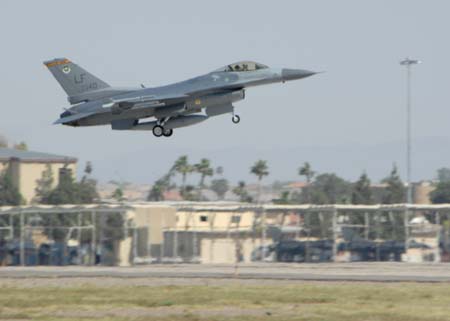Luke A ir Force Base in Arizona has just received the last of its F-16 fighters converted under the Common Configuration Implementation Program the Air Force initiated in 2001 and expects to complete fleet-wide by 2010. The intent of CCIP—directed at Block 40 and 42 Vipers—is to enhance their mission capability and to provide a similar configuration among the F-16s that USAF expect to last through the arrival of the F-35. CCIP upgrades, already resident in Block 50 and 52 versions, provide common avionics, Link 16 data transfer capability, the Joint Helmet-Mounted Cueing System, and other advanced capabilities. The service has been performing the CCIP upgrade in concert with its Falcon STAR structural improvement program, which has doubled the aircraft’s service life, from 4,000 hours to 8,000 hours, or 32 years. The Viper community welcomes the upgrade, as Capt. Ryan Pumford, 310th Fighter Squadron chief of scheduling at Luke, said, “The CCIP avionics suite increases warfighter situational awareness, survivability, and lethality keeping us on the tip of the spear as the world’s premier Air Force.” However, age of the airframe is still an issue. The Air Force expects to withdraw from service the last of its F-16s in 2025, when the average age of the fleet would be around 33-35 years. USAF expects to have about 620 F-35s on hand at that point, if current plans hold. (Read Making the Best of the Fighter Force from March 2007 Air Force Magazine) (Includes Luke report by SSgt. Phillip Butterfield)
ir Force Base in Arizona has just received the last of its F-16 fighters converted under the Common Configuration Implementation Program the Air Force initiated in 2001 and expects to complete fleet-wide by 2010. The intent of CCIP—directed at Block 40 and 42 Vipers—is to enhance their mission capability and to provide a similar configuration among the F-16s that USAF expect to last through the arrival of the F-35. CCIP upgrades, already resident in Block 50 and 52 versions, provide common avionics, Link 16 data transfer capability, the Joint Helmet-Mounted Cueing System, and other advanced capabilities. The service has been performing the CCIP upgrade in concert with its Falcon STAR structural improvement program, which has doubled the aircraft’s service life, from 4,000 hours to 8,000 hours, or 32 years. The Viper community welcomes the upgrade, as Capt. Ryan Pumford, 310th Fighter Squadron chief of scheduling at Luke, said, “The CCIP avionics suite increases warfighter situational awareness, survivability, and lethality keeping us on the tip of the spear as the world’s premier Air Force.” However, age of the airframe is still an issue. The Air Force expects to withdraw from service the last of its F-16s in 2025, when the average age of the fleet would be around 33-35 years. USAF expects to have about 620 F-35s on hand at that point, if current plans hold. (Read Making the Best of the Fighter Force from March 2007 Air Force Magazine) (Includes Luke report by SSgt. Phillip Butterfield)
In a grassroots effort, Airmen around the world are coming together to remember Senior Airman Roger Fortson, 23, who was killed by a sheriff’s deputy in Florida on May 3. On the social media platform Discord, Airmen from locations as distant as Osan Air Base, South Korea; Travis Air Force…